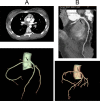Anomalous right coronary artery originating from the aorta: a series of nine pediatric cases
- PMID: 37907926
- PMCID: PMC10617201
- DOI: 10.1186/s12887-023-04377-4
Anomalous right coronary artery originating from the aorta: a series of nine pediatric cases
Abstract
Background: To investigate the clinical manifestations, prognosis, and possibly related genes of anomalous right coronary artery originating from the aorta (ARCA-L) in children.
Methods: This case series study included pediatric patients diagnosed with ARCA-L at the Department of Cardiology in Beijing Children's Hospital affiliated to Capital Medical University, between January 2017 and December 2019.
Results: Nine pediatric patients (aged 3 months to 12 years, 4 boys) were included. Two cases presented with cardiac insufficiency as their primary manifestation, while the remaining seven had post-infection or post-exercise symptoms such as chest pain, chest tightness, long exhalation, lack of strength, and dizziness. Six patients displayed varying degrees of ST-T changes on the electrocardiograph, while two patients had a reduced left ventricular ejection fraction (LVEF) of 20-32% according to echocardiography. Multislice computed tomographic angiography confirmed the presence of ARCA-L in all patients. One patient underwent the unroofing technique. The remaining eight received conservative treatment. After a follow-up of 2-64 months, eight children had a good prognosis and survived. One child experienced sudden death due to aggravated heart failure. Whole exome sequencing revealed that one child tested negative, one had mutations in the RYR2 and LDB3 genes, and the remaining four patients had a mutation in the GDF1, LRP6, MEF2A, and KALRN genes, respectively.
Conclusions: ARCA-L in children might have a wide variation in clinical manifestations and a risk of sudden death. The occurrence of the disease might be associated with genetic defects.
Keywords: Anomalous origin of coronary artery; Case series; Clinical manifestations; Pediatric; Prognosis; Whole-exome sequencing.
© 2023. The Author(s).
Conflict of interest statement
The authors declare no competing interests.
Figures


References
-
- Cheezum MK, Liberthson RR, Shah NR, Villines TC, O’Gara PT, Landzberg MJ, Blankstein R. Anomalous aortic origin of a coronary artery from the Inappropriate Sinus of Valsalva. J Am Coll Cardiol. 2017;69:1592–608. - PubMed
-
- Brothers JA, Gaynor JW, Jacobs JP, Caldarone C, Jegatheeswaran A, Jacobs ML. Anomalous coronary artery Working G: the registry of anomalous aortic origin of the coronary artery of the congenital heart surgeons’ Society. Cardiol Young. 2010;20(Suppl 3):50–8. - PubMed
-
- Molossi S, Agrawal H. Coronary artery anomalies: a multidisciplinary approach to shape the landscape of a challenging problem. Congenit Heart Dis. 2017;12:596. - PubMed
Publication types
MeSH terms
LinkOut - more resources
Full Text Sources
Medical

